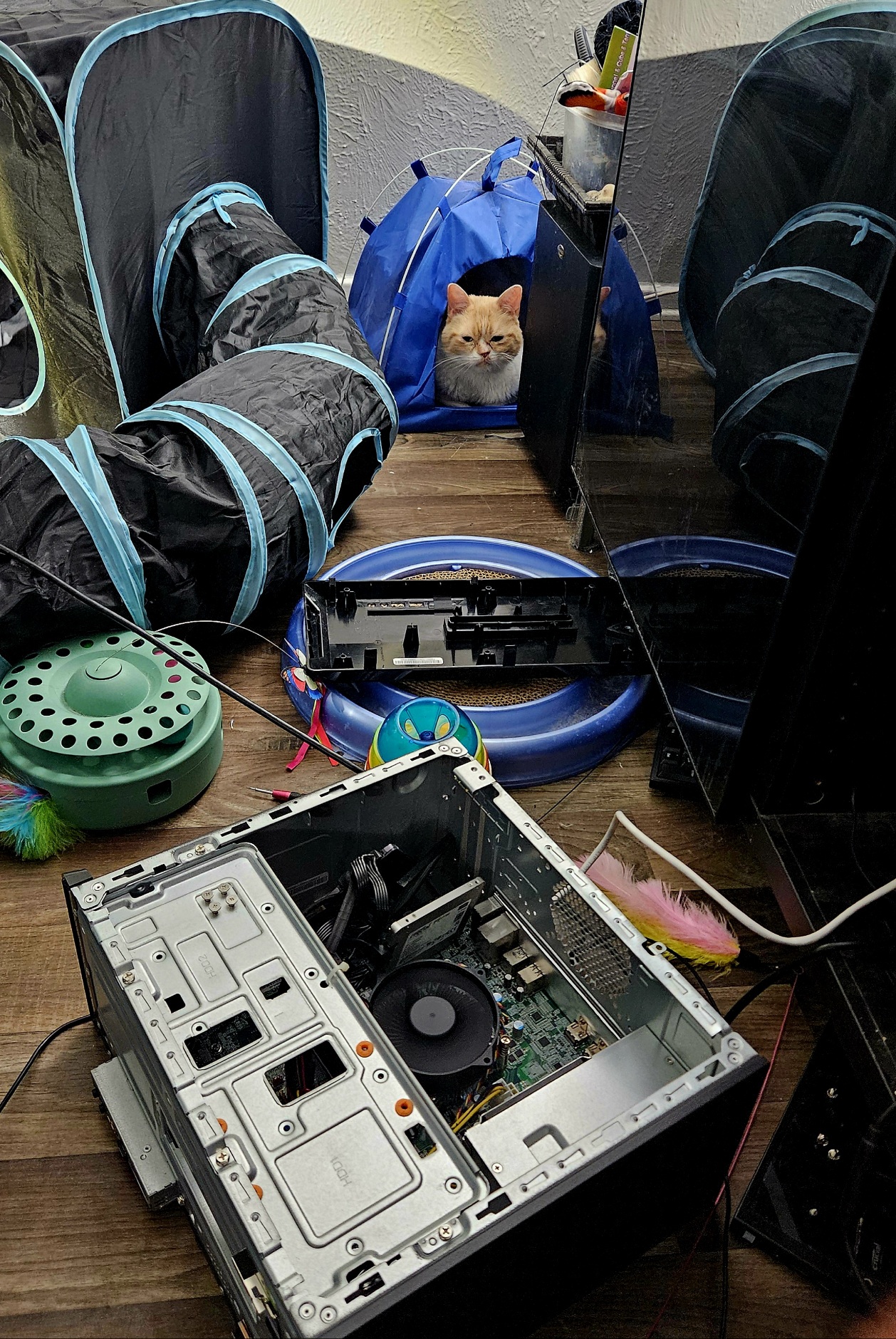

minnix
Admin: lemux
Issues and Updates: !server_news
Find me:
mastodon: @minnix@upallnight.minnix.dev
matrix: @minnix:minnix.dev
peertube: @minnix@nightshift.minnix.dev
funkwhale: @minnix@allnightlong.minnix.dev
writefreely: @minnix@tech.minnix.dev
- 4 Posts
- 70 Comments
There is no way to get acceptable IOPS out of HDDs within Proxmox. Your IO delay will be insane. You could at best stripe a ton of HDDs but even then one enterprise grade SSD will smoke it as far as performance goes. Post screenshots of your current Proxmox HDD/SSD disk setup with your ZFS pool, services, and IO delay and then we can talk. The difference that enterprise gives you is night and day.
ZFS absolutely does not require them in any way.
Who said it does? Also regarding Proxmox:
https://forum.proxmox.com/threads/consumer-grade-ssds.141190/post-632197
Yes I’m specifically referring to your ZFS pool containing your VMs/LXCs. Enterprise SSDs for that. Get them on ebay. Just do a search on the Proxmox forums for enterprise vs consumer SSD to see the problem with consumer hardware for ZFS. For Proxmox itself you want something like an NVME with DRAM, specifically underprovisioned for an unused space buffer for the drive controller to use for wear leveling.


I did something similar when migrating to 8. Consumer SSDs suck with proxmox so I bought 2 enterprise SSDs on Ebay before the migration and decided to do everything at once. I didn’t have all the moving parts you did though. If you have an issue, you will more than likely not be able to pop back in the old SSDs and expect everything to work as normal. I’m not sure what you’re using to create backups but if you’re not already I would recommend PBS. This way if there is an issue, restoring your VMs is trivial. As long as that PBS is up and running correctly (makes sure to restore a backup before making any changes to make sure it works as intended) it should be ok. I have 2 PBS’s. One on and off site.
PBS will keep the correct IPs of your VMs so reconnecting NFS shares shouldn’t be an issue either.
I’ve ran jitsi for 4 years now. You can keep your personal variables in an environment file that doesn’t really change and pull down a new compose file whenever you want to update. Ever since the switch to docker from native install it has made things much easier to maintain. I’m using a lxc with debian 12. 4 cores and 4gb ram. The only reason I’ve allocated that many resources is because we use it to record a podcast with anywhere from 4 to 10 people on the server at a time. As far as bitrate, resolution, etc, that’s all handled within your env file. You’d have to look at the docs to see what’s available for you to choose from.
I have it installed for a few years now. I started with the AIO but moved to the separate container install after AIO was deprecated. I imagine the install process is too complex for portainer. https://docs.funkwhale.audio/stable/administrator/installation/docker.html
I did steps 1-4 and skipped the rest because I already have a proxy server running. Don’t remember anything related to snapd though. Mine is running in a Debian 11 VM on proxmox instead of an LXC, but the process should be the same. Also they have a matrix channel for help https://matrix.to/#/#funkwhale-support:matrix.org
From what I remember it was relatively painless to install, but upgrading can be a chore, especially this last upgrade. My main interest in FW was the federation aspect as far as finding new music. If you don’t care about federation, maybe a simpler option would work better for you.
At the very least you need to install a webserver and you need a proxy of some kind. If you truly want old school you can just create html pages hosted from the root of your webserver (although there are now easier modern ways to do this, you might learn more the classic way rather than using a CMS).
You will want a reverse proxy to lie between your webserver and the internet that handles SSL. Let’s Encrypt is a good option to generate a cert so that you only expose port 443 on your router to the internet and your webserver. You’ll have to open port 80 to generate the cert but can close it again once generated. Then you will have https.
That’s the basics. The how-to’s are easy to find online.
I’m not sure how soon you need this, but if you can wait sipeed has a $20 kvm with ATX control that should be out soon https://lunar.computer/news/sipeed-announces-new-20-risc-v-kvm-device/


There’s an interesting book I read recently related to this called The Anxious Generation: how the Great Rewiring of Childhood is Causing an Epidemic of Mental Illness. I’d recommend it.
As a counterpoint, EFF put out this article today: The Surgeon General’s Fear-Mongering, Unconstitutional Effort to Label Social Media


Elaborate on why samba is bad when it comes to security? Like list a bunch of links like this or write a paragraph summarizing them like a chatbot?


NFS does symlinks but they have to be configured correctly.
Samba may have not given you issues in the past, but it also doesn’t give you any security.
It’s extremely light to run, and very easy to install and upgrade. I ran one for just myself without open registrations. The only con is that the community (self-hostable) version doesn’t allow js due to “safety reasons” so in order to have something like comments for your blog you have to either perform several janky CSS hacks or adjust the source code yourself. The only reason I chose wf was because of federation, but I eventually switched to standard WordPress with the federation plugin and now have comments and whatever else I want.
I started using Frigate and thought about going the Coral route but realized you didn’t need them if you have a relatively recent Intel CPU (6th gen or newer) as OpenVino with the iGPU is pretty much on par https://github.com/blakeblackshear/frigate/discussions/5742 .
A lot of the newer SBCs are being shipped with integrated NPUs/TPUs now as well. I would get a Coral if I were to use an older SBC or RPi or older PC as a camera server for object detection. Currently I have an ESP32-CAM watching a bird feeder but that feed goes to a modern server for bird species recognition but I could see a Coral as an option.
I like Librum for reading, as far as finding https://lemmy.ml/c/piracy may know
Traffic take longer? You’re talking about milliseconds. Also Wake On Lan has been baked into BIOS’s and Network cards for years so there’s no need to waste power. Is the issue that you just don’t have a PC? Regardless, if this is the path you want to take I think it’s a cool learning experience and I’m interested in seeing how it turns out.
This might be what you’re looking for https://lemux.minnix.dev/post/157074



I was asking them to post their setup so I can evaluate their experience with regards to Proxmox and disk usage.